Artificial Intelligence Applied to Computational Fluid Dynamics and Its Application in Thermal Energy Storage: A Bibliometric Analysis
Abstract
1. Introduction
2. AI in CFD: Overview and Perspective
2.1. CFD History and Overview
2.2. Using AI in CFD
2.3. CFD for Thermal Energy Storage
3. Methodology
4. Results and Discussion
4.1. First Query: Use of AI on CFD
4.1.1. Analysis of Countries
4.1.2. Analysis of Institutions
4.1.3. Analysis of Funding Sponsor
4.1.4. Analysis of Publication Source
4.1.5. Analysis About Author
4.1.6. Keyword Analysis
4.2. AI Applied to CFD with a Focus on the TES Field
4.2.1. Analysis by Countries
4.2.2. Affiliation Analysis
4.2.3. Analysis of Funding Sponsor
4.2.4. Analysis of Source
4.2.5. Authorship Analysis
4.2.6. Analysis About Keyword
5. Conclusions
Author Contributions
Funding
Institutional Review Board Statement
Informed Consent Statement
Data Availability Statement
Acknowledgments
Conflicts of Interest
References
- What Is a CFD Simulation (Flow Simulation) ?—Goebel Engineering. Available online: https://www.goebel-engineering.com/en/what-is-a-cfd-flow-simulation/ (accessed on 16 May 2023).
- Blazek, J. Introduction. In Computational Fluid Dynamics: Principles and Applications; Elsevier: Amsterdam, The Netherlands, 2015; pp. 1–5. [Google Scholar] [CrossRef]
- Wendt, J.F.; Anderson, J.D.; Degroote, J.; Degrez, G.; Dick, E.; Grundmann, R.; Vierendeels, J. Computational Fluid Dynamics: An Introduction; Springer: Berlin/Heidelberg, Germany, 2009; pp. 1–332. [Google Scholar] [CrossRef]
- Xamán, J.; Gijón-Rivera, M. Dinámica de Fluidos Computacional para Ingenieros; Palibrio: Boston, MA, USA, 2013. [Google Scholar]
- The Ansys Story. 2024. Available online: https://www.Ansys.Com/Company-Information/the-Ansys-Story (accessed on 15 February 2025).
- COMSOL—Software for Multiphysics Simulation. Available online: https://www.comsol.com/ (accessed on 16 May 2023).
- OpenFOAM. Available online: https://www.openfoam.com/ (accessed on 9 January 2025).
- Autodesk CFD Software|Get Prices & Buy Official CFD. Available online: https://www.autodesk.com/in/products/cfd/overview?msockid=3e0df39f3baf68b0168ee1333a076942 (accessed on 9 January 2025).
- Simcenter STAR-CD—Simcenter. Available online: https://blogs.sw.siemens.com/simcenter/product/simcenter-star-cd/ (accessed on 9 January 2025).
- Kolditz, O. Finite Volume Method. In Computational Methods in Environmental Fluid Mechanics; Springer: Berlin/Heidelberg, Germany, 2002; pp. 173–190. [Google Scholar] [CrossRef]
- Morton, K.W.; Mayers, D.F. Numerical Solution of Partial Differential Equations: An Introduction; Cambridge University Press: Cambridge, UK, 2005; pp. 1–279. [Google Scholar] [CrossRef]
- Zhu, H.P.; Zhou, Z.Y.; Yang, R.Y.; Yu, A.B. Discrete particle simulation of particulate systems: Theoretical developments. Chem. Eng. Sci. 2007, 62, 3378–3396. [Google Scholar] [CrossRef]
- Plewa, T.; Linde, T.; Gregory Weirs, V. (Eds.) Adaptive Mesh Refinement—Theory and Applications; Springer: Berlin/Heidelberg, Germany, 2005; Volume 41. [Google Scholar] [CrossRef]
- Kochkov, D.; Smith, J.A.; Alieva, A.; Wang, Q.; Brenner, M.P.; Hoyer, S. Machine learning–accelerated computational fluid dynamics. Proc. Natl. Acad. Sci. USA 2021, 118, e2101784118. [Google Scholar] [CrossRef]
- Jordan, M.I.; Mitchell, T.M. Machine learning: Trends, perspectives, and prospects. Science 2015, 349, 255–260. [Google Scholar] [CrossRef]
- Romano, J.P.; Baysal, O. Convolutional-neural-network-based Auto-encoder for Synthetic Upscaling of Computational Fluid Dynamics Simulations. In Proceedings of the AIAA Science and Technology Forum and Exposition, AIAA SciTech Forum 2022, San Diego, CA, USA, 3–7 January 2022. [Google Scholar] [CrossRef]
- Heinz, S. The Potential of Machine Learning Methods for Separated Turbulent Flow Simulations: Classical Versus Dynamic Methods. Fluids 2024, 9, 278. [Google Scholar] [CrossRef]
- Cai, K.; Wang, J. Physics-informed neural networks for solving incompressible Navier-Stokes equations in wind engineering. Phys. Fluids 2024, 36, 121303. [Google Scholar] [CrossRef]
- Hacioğlu, A. A novel usage of neural network in optimization and implementation to the internal flow systems. Aircr. Eng. Aerosp. Technol. 2005, 77, 369–375. [Google Scholar] [CrossRef]
- Lira, J.O.B.; Riella, H.G.; Padoin, N.; Soares, C. Computational fluid dynamics (CFD), artificial neural network (ANN) and genetic algorithm (GA) as a hybrid method for the analysis and optimization of micro-photocatalytic reactors: NOx abatement as a case study. Chem. Eng. J. 2022, 431, 133771. [Google Scholar] [CrossRef]
- Usman, A.; Rafiq, M.; Saeed, M.; Nauman, A.; Almqvist, A.; Liwicki, M. Machine Learning Computational Fluid Dynamics. In Proceedings of the 2021 Swedish Artificial Intelligence Society Workshop (SAIS), Lulea, Sweden, 14–15 June 2021; pp. 1–4. [Google Scholar] [CrossRef]
- Zhou, S.; Liu, X.; Du, G.; Liu, C.; Zhou, Y. Comparison study of CFD and Artificial Neural Networks in predicting temperature fields induced by natural convention in a square enclosure. Therm. Sci. 2018, 2018, 3481–3492. [Google Scholar] [CrossRef]
- Chickerur, S.; Ashish, P. A Convolutional Neural Network Based Approach for Computational Fluid Dynamics. In Proceedings of the 2021 2nd International Conference on Smart Technologies in Computing, Electrical and Electronics, ICSTCEE 2021, Bengaluru, India, 16–17 December 2021. [Google Scholar] [CrossRef]
- McCulloch, W.S.; Pitts, W. A logical calculus of the ideas immanent in nervous activity. Bull. Math. Biophys. 1943, 5, 115–133. [Google Scholar] [CrossRef]
- Lecun, Y.; Bottou, L.; Bengio, Y.; Haffner, P. Gradient-based learning applied to document recognition. Proc. IEEE 1998, 86, 2278–2324. [Google Scholar] [CrossRef]
- Oldenburg, J.; Borowski, F.; Öner, A.; Schmitz, K.-P.; Stiehm, M. Geometry aware physics informed neural network surrogate for solving Navier–Stokes equation (GAPINN). Adv. Model. Simul. Eng. Sci. 2022, 9, 8. [Google Scholar] [CrossRef]
- Jalili, D.; Jang, S.; Jadidi, M.; Giustini, G.; Keshmiri, A.; Mahmoudi, Y. Physics-informed neural networks for heat transfer prediction in two-phase flows. Int. J. Heat Mass Transf. 2024, 221, 125089. [Google Scholar] [CrossRef]
- Botarelli, T.; Fanfani, M.; Nesi, P.; Pinelli, L. Using Physics-Informed neural networks for solving Navier-Stokes equations in fluid dynamic complex scenarios. Eng. Appl. Artif. Intell. 2025, 148, 110347. [Google Scholar] [CrossRef]
- Prieto, C.; Cabeza, L.F. Thermal energy storage (TES) with phase change materials (PCM) in solar power plants (CSP). Concept and plant performance. Appl. Energy 2019, 254, 113646. [Google Scholar] [CrossRef]
- Cabeza, L.F.; Martorell, I.; Miró, L.; Fernández, A.I.; Barreneche, C. Introduction to thermal energy storage (TES) systems. In Advances in Thermal Energy Storage Systems; Elsevier: Amsterdam, The Netherlands, 2015; pp. 1–28. [Google Scholar] [CrossRef]
- Hathal, M.M.; Al-Jadir, T.; Al-Sheikh, F.; Edan, M.S.; Haider, M.J.; Rsool, R.A.; Haider, A.J.; Badawy, T.; Al jubori, A.M. Thermal performance characterization of a thermal energy storage tank with various phase change materials. Int. J. Thermofluids 2023, 18, 100322. [Google Scholar] [CrossRef]
- Bahlekeh, A.; Mohammed, H.I.; Al-Azzawi, W.K.; Dulaimi, A.; Majdi, H.S.; Talebizadehsardari, P.; Mahdi, J.M. CFD analysis on optimizing the annular fin parameters toward an improved storage response in a triple-tube containment system. Energy Sci. Eng. 2022, 10, 4814–4839. [Google Scholar] [CrossRef]
- Chekifi, T.; Boukraa, M. CFD applications for sensible heat storage: A comprehensive review of numerical studies. J. Energy Storage 2023, 68, 107893. [Google Scholar] [CrossRef]
- Al-Abidi, A.A.; Mat, S.B.; Sopian, K.; Sulaiman, M.Y.; Mohammed, A.T. CFD applications for latent heat thermal energy storage: A review. Renew. Sustain. Energy Rev. 2013, 20, 353–363. [Google Scholar] [CrossRef]
- Zheng, S.; Li, S.; Hu, C.; Li, W. Performance optimization of latent heat storage device based on surrogate-assisted multi-objective evolutionary algorithm and CFD method. J. Energy Storage 2024, 99, 113338. [Google Scholar] [CrossRef]
- Darzi, A.A.R.; Mousavi, S.M.; Razbin, M.; Li, M. Utilizing neural networks and genetic algorithms in AI-assisted CFD for optimizing PCM-based thermal energy storage units with extended surfaces. Therm. Sci. Eng. Prog. 2024, 54, 102795. [Google Scholar] [CrossRef]
- Jarneving, B. Bibliographic coupling and its application to research-front and other core documents. J. Informetr. 2007, 1, 287–307. [Google Scholar] [CrossRef]
- Bornmann, L.; Leydesdorff, L. Scientometrics in a changing research landscape: Bibliometrics has become an integral part of research quality evaluation and has been changing the practice of research. EMBO Rep. 2014, 15, 1228–1232. [Google Scholar] [CrossRef]
- Google Académico. Available online: https://scholar.google.com/ (accessed on 5 February 2025).
- Document Search—Web of Science Core Collection. Available online: https://www.webofscience.com/wos/woscc/basic-search (accessed on 5 February 2025).
- Scopus—Document Search. Available online: https://www.scopus.com/search/form.uri#basic (accessed on 5 February 2025).
- Mongeon, P.; Paul-Hus, A. The journal coverage of Web of Science and Scopus: A comparative analysis. Scientometrics 2016, 106, 213–228. [Google Scholar] [CrossRef]
- Falagas, M.E.; Pitsouni, E.I.; Malietzis, G.A.; Pappas, G. Comparison of PubMed, Scopus, Web of Science, and Google Scholar: Strengths and weaknesses. FASEB J. 2008, 22, 338–342. [Google Scholar] [CrossRef]
- PubMed. Available online: https://pubmed.ncbi.nlm.nih.gov/ (accessed on 5 February 2025).
- Cabeza, L.F.; Chàfer, M.; Mata, É. Comparative Analysis of Web of Science and Scopus on the Energy Efficiency and Climate Impact of Buildings. Energies 2020, 13, 409. [Google Scholar] [CrossRef]
- Wuni, I.Y.; Shen, G.Q.P.; Osei-Kyei, R. Scientometric review of global research trends on green buildings in construction journals from 1992 to 2018. Energy Build. 2019, 190, 69–85. [Google Scholar] [CrossRef]
- Home|SpringerLink. Available online: https://link.springer.com/ (accessed on 5 February 2025).
- IEEE—The World’s Largest Technical Professional Organization Dedicated to Advancing Technology for the Benefit of Humanity. Available online: https://www.ieee.org/ (accessed on 5 February 2025).
- Scopus Content|Elsevier. Available online: https://www.elsevier.com/products/scopus/content?dgcid=RN_AGCM_Sourced_300005030#0-content-coverage (accessed on 22 January 2025).
- La Solución Probada para el Diseño y Desarrollo de Productos en 3D|SOLIDWORKS. Available online: https://www.solidworks.com/es (accessed on 5 February 2025).
- Lecun, Y.; Bengio, Y.; Hinton, G. Deep learning. Nature 2015, 521, 436–444. [Google Scholar] [CrossRef]
- De Gracia, A.; Cabeza, L.F. Phase change materials and thermal energy storage for buildings. Energy Build. 2015, 103, 414–419. [Google Scholar] [CrossRef]
- Zalba, B.; Marín, J.M.; Cabeza, L.F.; Mehling, H. Mehling, Review on thermal energy storage with phase change: Materials, heat transfer analysis and applications. Appl. Therm. Eng. 2003, 23, 251–283. [Google Scholar] [CrossRef]
- Welcome to Python.org. Available online: https://www.python.org/ (accessed on 16 May 2023).
- VOSviewer—Visualizing Scientific Landscapes. Available online: https://www.vosviewer.com/ (accessed on 15 January 2025).
- van Eck, N.J.; Waltman, L. Software survey: VOSviewer, a computer program for bibliometric mapping. Scientometrics 2010, 84, 523–538. [Google Scholar] [CrossRef]
- van Eck, N.J.; Waltman, L. VOS: A New Method for Visualizing Similarities Between Objects. In Advances in Data Analysis; Decker, R., Lenz, H.-J., Eds.; Springer: Berlin/Heidelberg, Germany, 2007; pp. 299–306. [Google Scholar]
- Borg, I.; Groenen, P.J.F. Modern Multidimensional Scaling; Springer: New York, NY, USA, 2005. [Google Scholar] [CrossRef]
- van Eck, N.J.; Waltman, L. Citation-based clustering of publications using CitNetExplorer and VOSviewer. Scientometrics 2017, 111, 1053–1070. [Google Scholar] [CrossRef] [PubMed]
- AI Index Report 2024—Artificial Intelligence Index. Available online: https://aiindex.stanford.edu/report/#individual-chapters (accessed on 17 December 2024).
- E.B. [D-T.-30] Rep. Johnson, H.R.6216—116th Congress (2019-2020): National Artificial Intelligence Initiative Act of 2020. 2020. Available online: https://www.congress.gov/bill/116th-congress/house-bill/6216 (accessed on 17 December 2024).
- Gathering Strength, Gathering Storms: The One Hundred Year Study on Artificial Intelligence (AI100) 2021 Study Panel Report|One Hundred Year Study on Artificial Intelligence (AI100). Available online: https://ai100.stanford.edu/gathering-strength-gathering-storms-one-hundred-year-study-artificial-intelligence-ai100-2021-study (accessed on 5 February 2025).
- What Is Made in China 2025 and Why Is the World So Nervous? Available online: https://www.china-briefing.com/news/made-in-china-2025-explained (accessed on 29 January 2025).
- Made in China 2025 Plan Thrives with Subsidies for Tech and EV Makers. Available online: https://www.ft.com/content/f7df0f64-25b5-4526-82fa-ca1b554b541b (accessed on 29 January 2025).
- United Nations. United Nations|Peace, Dignity and Equality on a Healthy Planet. Available online: https://www.un.org/en (accessed on 5 February 2025).
- Your Gateway to the EU, News, Highlights|European Union. Available online: https://european-union.europa.eu/index_en (accessed on 5 February 2025).
- Hidayat, E.Y.; Hastuti, K.; Muda, A.K. Artificial intelligence in digital image processing: A bibliometric analysis. Intell. Syst. Appl. 2025, 25, 200466. [Google Scholar] [CrossRef]
- What We Do—Ministry of Education of the People’s Republic of China. Available online: http://en.moe.gov.cn/about_MOE/what_we_do/ (accessed on 31 January 2025).
- About Us—Chinese Academy of Sciences. Available online: https://english.cas.cn/about_us/ (accessed on 31 January 2025).
- Yang, M.; Ni, H. Educational Governance in China; Springer Nature: Singapore, 2018; pp. 1–319. [Google Scholar] [CrossRef]
- Making Sense of China’s Government Budget|ChinaPower Project. Available online: https://chinapower.csis.org/making-sense-of-chinas-government-budget/ (accessed on 1 February 2025).
- Xie, Q.; Freeman, R.B. China’s Overwhelming Contribution to Scientific Publications. 2018. Available online: https://scholar.harvard.edu/files/freeman/files/china_overwhelming_contribution_to_scientific_publications_ms_science_voxchina_xie-freeman_sept2018.pdf (accessed on 1 March 2025).
- About Us—NSFC at a Glance. Available online: https://www.nsfc.gov.cn/english/site_1/about/6.html (accessed on 1 February 2025).
- Ministry of Science and Technology of the People’s Republic of China. Available online: https://en.most.gov.cn/ (accessed on 1 February 2025).
- Liu, Y.; Gao, Z.; Wang, H.; Wang, J.; Shen, J.; Wang, C. Analysis of projects funded by the National Natural Science Foundation of China during the years of 2014–2018. Ann. Transl. Med. 2019, 7, 267. [Google Scholar] [CrossRef] [PubMed]
- Department of Energy. Available online: https://www.energy.gov/ (accessed on 1 February 2025).
- U.S. Department of Energy, Analysis of Federal Funding for Research and Development in 2022: Basic Research|NSF—National Science Foundation. Available online: https://ncses.nsf.gov/pubs/nsf24332 (accessed on 1 February 2025).
- NSF—National Science Foundation. Available online: https://new.nsf.gov/ (accessed on 1 February 2025).
- U.S. Department of Energy, Fiscal Year 2024 Appropriations|NSF—National Science Foundation. Available online: https://new.nsf.gov/about/budget/fy2024/appropriations (accessed on 1 February 2025).
- European Commission. Horizon 2020|Horizon 2020. 2022. Available online: https://wayback.archive-it.org/12090/20220124075100/https:/ec.europa.eu/programmes/horizon2020/ (accessed on 2 February 2025).
- European Commission. Horizon 2020—European Commission. Available online: https://research-and-innovation.ec.europa.eu/funding/funding-opportunities/funding-programmes-and-open-calls/horizon-2020_en?utm_source=chatgpt.com (accessed on 2 February 2025).
- European Commission, Staff Working Document: Ex-post Evaluation of Horizon 2020, the EU Framework Programme for Research and Innovation, Brussels. 2024. Available online: https://eur-lex.europa.eu/resource.html?uri=cellar:b5a1da8b-be92-11ee-b164-01aa75ed71a1.0001.02/DOC_1&format=PDF (accessed on 2 February 2025).
- CoE RAISE Consortium, CoE RAISE|European Center of Excellence|AI Technology Development. Available online: https://www.coe-raise.eu/ (accessed on 2 February 2025).
- Hirsch, J.E. An index to quantify an individual’s scientific research output. Proc. Natl. Acad. Sci. USA 2005, 102, 16569–16572. [Google Scholar] [CrossRef]
- Scimago Journal & Country Rank. Available online: https://www.scimagojr.com/ (accessed on 2 February 2025).
- Physics of Fluids|AIP Publishing. Available online: https://pubs.aip.org/aip/pof (accessed on 5 February 2025).
- Cao, Y.; Babanezhad, M.; Rezakazemi, M.; Shirazian, S. Prediction of fluid pattern in a shear flow on intelligent neural nodes using ANFIS and LBM. Neural Comput. Appl. 2020, 32, 13313–13321. [Google Scholar] [CrossRef]
- Babanezhad, M.; Rezakazemi, M.; Hajilary, N.; Shirazian, S. Liquid-Phase Chemical Reactors: Development of 3D Hybrid Model Based on CFD-Adaptive Network-Based Fuzzy Inference System. Can. J. Chem. Eng. 2018, 97, 1676–1684. [Google Scholar] [CrossRef]
- Jang, J.S.R. ANFIS: Adaptive-Network-Based Fuzzy Inference System. IEEE Trans. Syst. Man Cybern. 1993, 23, 665–685. [Google Scholar] [CrossRef]
- Tian, E.; Babanezhad, M.; Rezakazemi, M.; Shirazian, S. Simulation of a Bubble-Column Reactor by Three-Dimensional CFD: Multidimension- and Function-Adaptive Network-Based Fuzzy Inference System. Int. J. Fuzzy Syst. 2020, 22, 477–490. [Google Scholar] [CrossRef]
- Babanezhad, M.; Nakhjiri, A.T.; Marjani, A.; Shirazian, S. Pattern recognition of the fluid flow in a 3D domain by combination of Lattice Boltzmann and ANFIS methods. Sci. Rep. 2020, 10, 15908. [Google Scholar] [CrossRef]
- Babanezhad, M.; Behroyan, I.; Nakhjiri, A.T.; Marjani, A.; Shirazian, S. Computational Modeling of Transport in Porous Media Using an Adaptive Network-Based Fuzzy Inference System. ACS Omega 2020, 5, 30826–30835. [Google Scholar] [CrossRef]
- Pishnamazi, M.; Babanezhad, M.; Nakhjiri, A.T.; Rezakazemi, M.; Marjani, A.; Shirazian, S. ANFIS grid partition framework with difference between two sigmoidal membership functions structure for validation of nanofluid flow. Sci. Rep. 2020, 10, 15395. [Google Scholar] [CrossRef] [PubMed]
- Rezakazemi, M.; Mosavi, A.; Shirazian, S. ANFIS pattern for molecular membranes separation optimization. J. Mol. Liq. 2019, 274, 470–476. [Google Scholar] [CrossRef]
- Liu, Y.; Guo, J.; Li, W.; Yang, X.; Li, W.; Zhou, M.; Zhang, J. Comparison and estimation on deagglomeration performance of batch high shear mixers for nanoparticle suspensions. Chem. Eng. J. 2022, 429, 132420. [Google Scholar] [CrossRef]
- Guo, X.; Li, W.; Iorio, F. Convolutional neural networks for steady flow approximation. In Proceedings of the ACM SIGKDD International Conference on Knowledge Discovery and Data Mining, San Francisco, CA, USA, 13–17 August 2016; pp. 481–490. [Google Scholar] [CrossRef]
- El-Sawi, A.; Haghighat, F.; Akbari, H. Assessing long-term performance of centralized thermal energy storage system. Appl. Therm. Eng. 2013, 61, 313–321. [Google Scholar] [CrossRef]
- Kim, S.Y.; Kim, B.R.; Jeong, Y.S.; Ha, M.Y. Numerical Study on the Effect of Aspect Ratio and Center Distance of Elliptical Shell and Tube on the Melting Performance of the Latent Heat Storage System. Trans. Korean Soc. Mech. Eng. B 2024, 48, 623–635. [Google Scholar] [CrossRef]
- Mehraj, N.; Mateu, C.; Cabeza, L.F. Use of artificial intelligence methods in designing thermal energy storage tanks: A bibliometric analysis. J. Energy Storage 2024, 97, 112794. [Google Scholar] [CrossRef]
- İzgi, B. Machine learning-driven multi-objective optimization of fin geometry for enhanced charging and discharging performance in LTES system. J. Energy Storage 2024, 98, 113210. [Google Scholar] [CrossRef]
- Iyer, K.; Malick, H.A.; Nair, S.; Harish, R. CFD-ML analysis of finned pipe hybrid PCM systems for enhanced cold energy storage. Case Stud. Therm. Eng. 2025, 69, 106000. [Google Scholar] [CrossRef]
- Koga, K.; Shiraishi, Y. Optimal control of TABS using a combined method of MPC< and heat load prediction. Jpn. Archit. Rev. 2023, 6, e12311. [Google Scholar] [CrossRef]
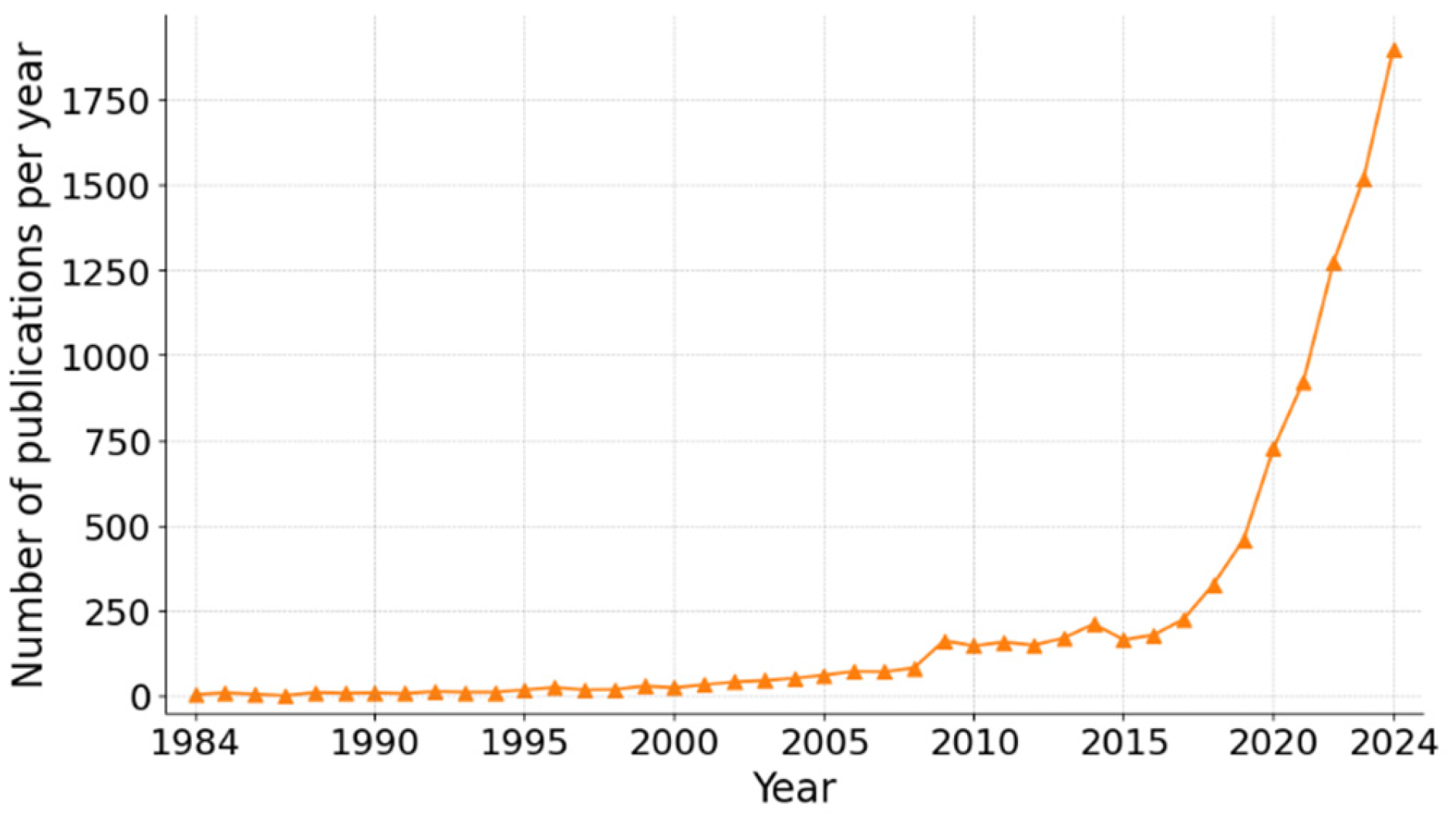
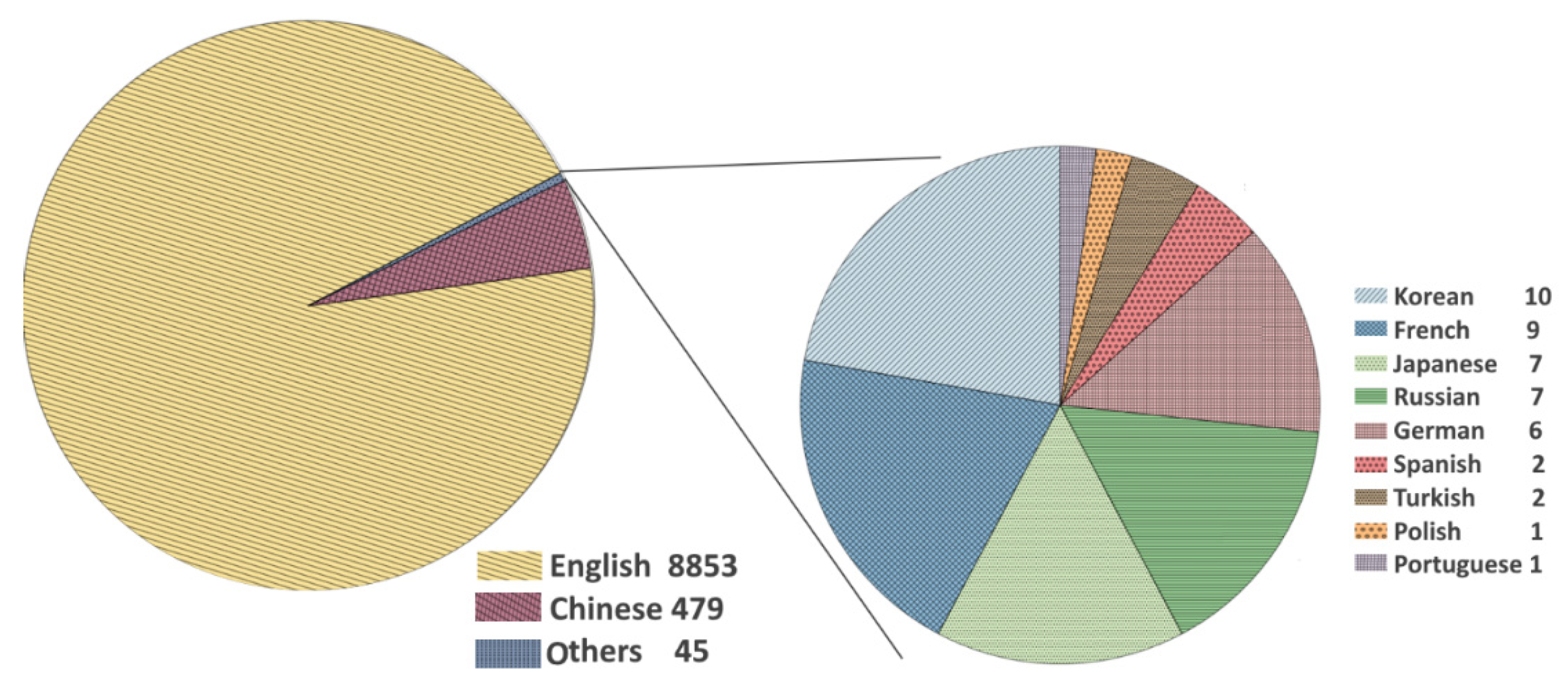
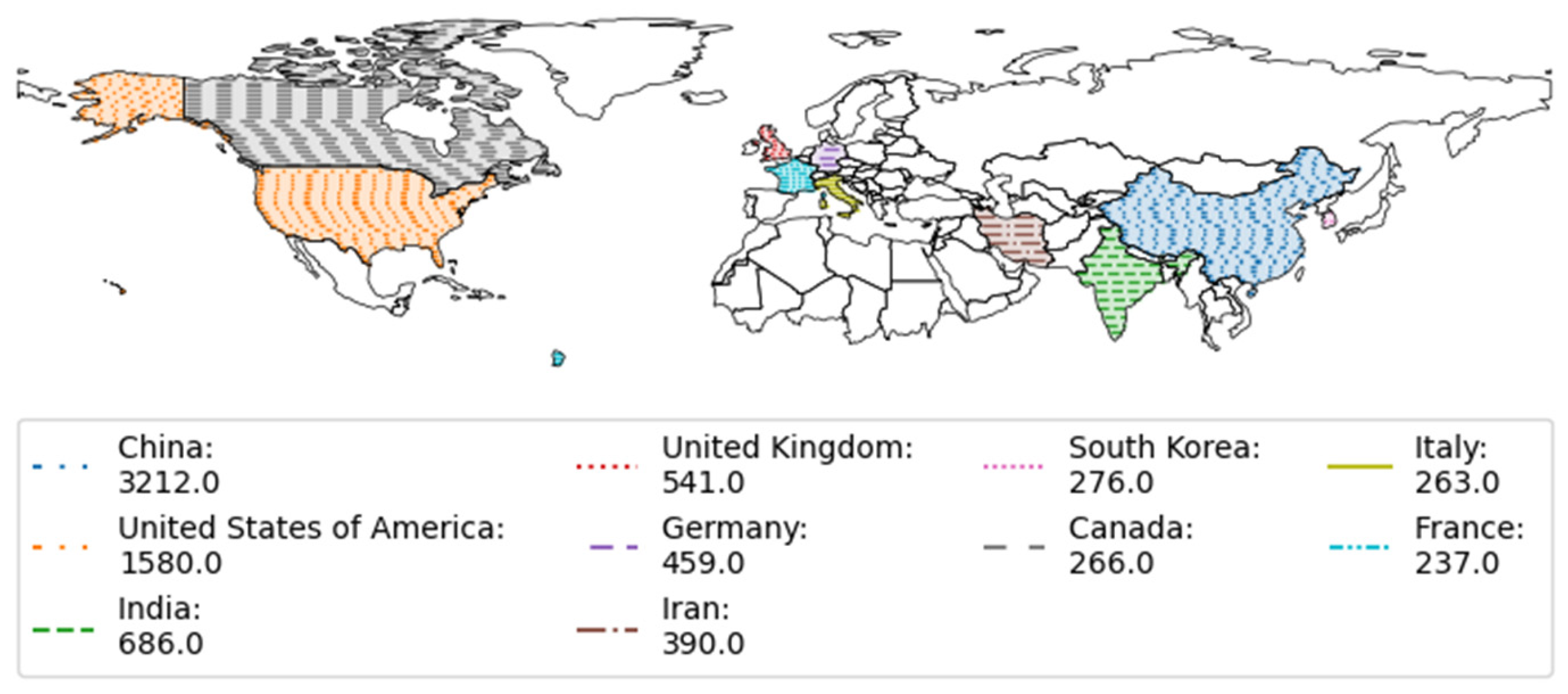

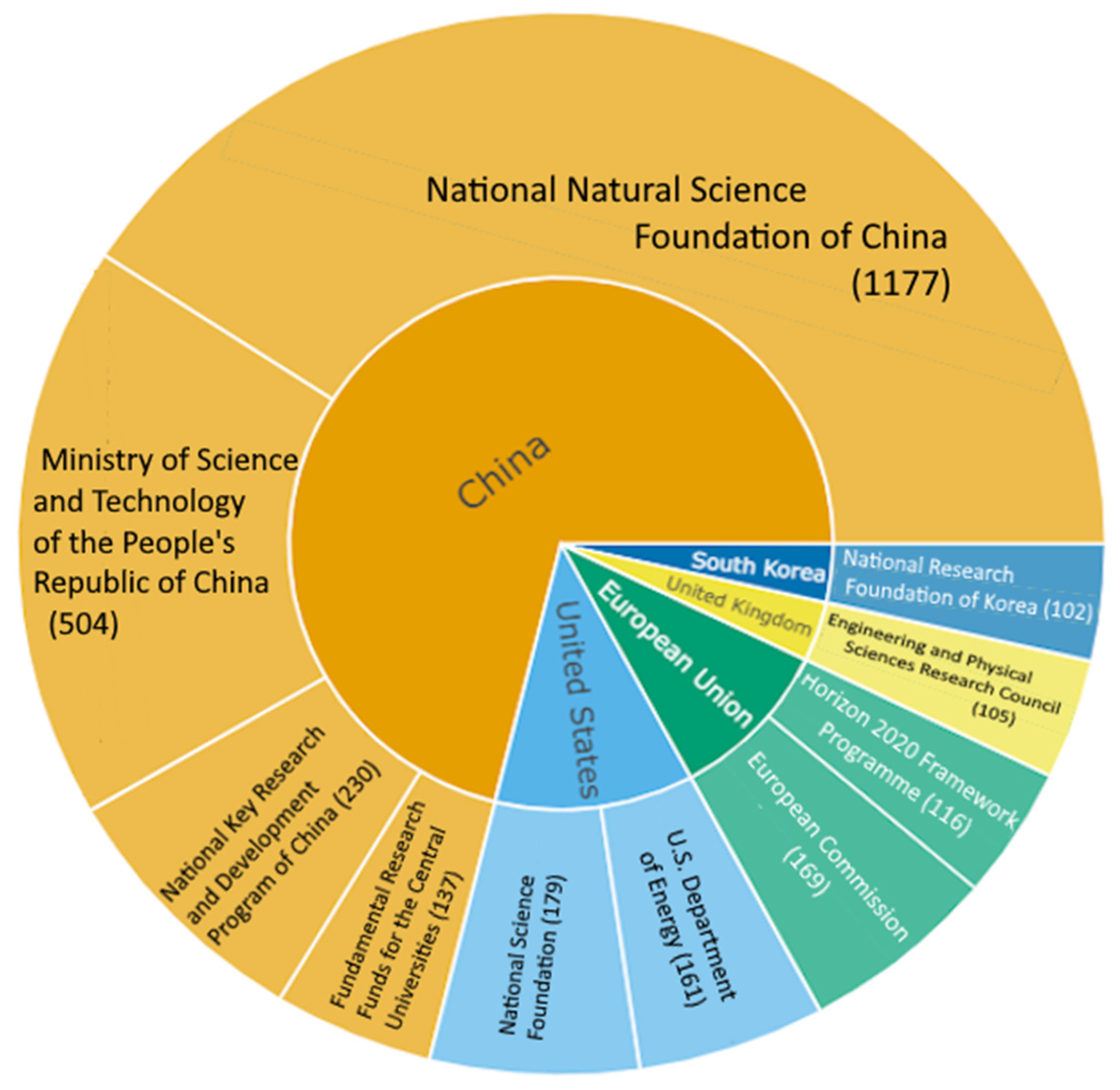
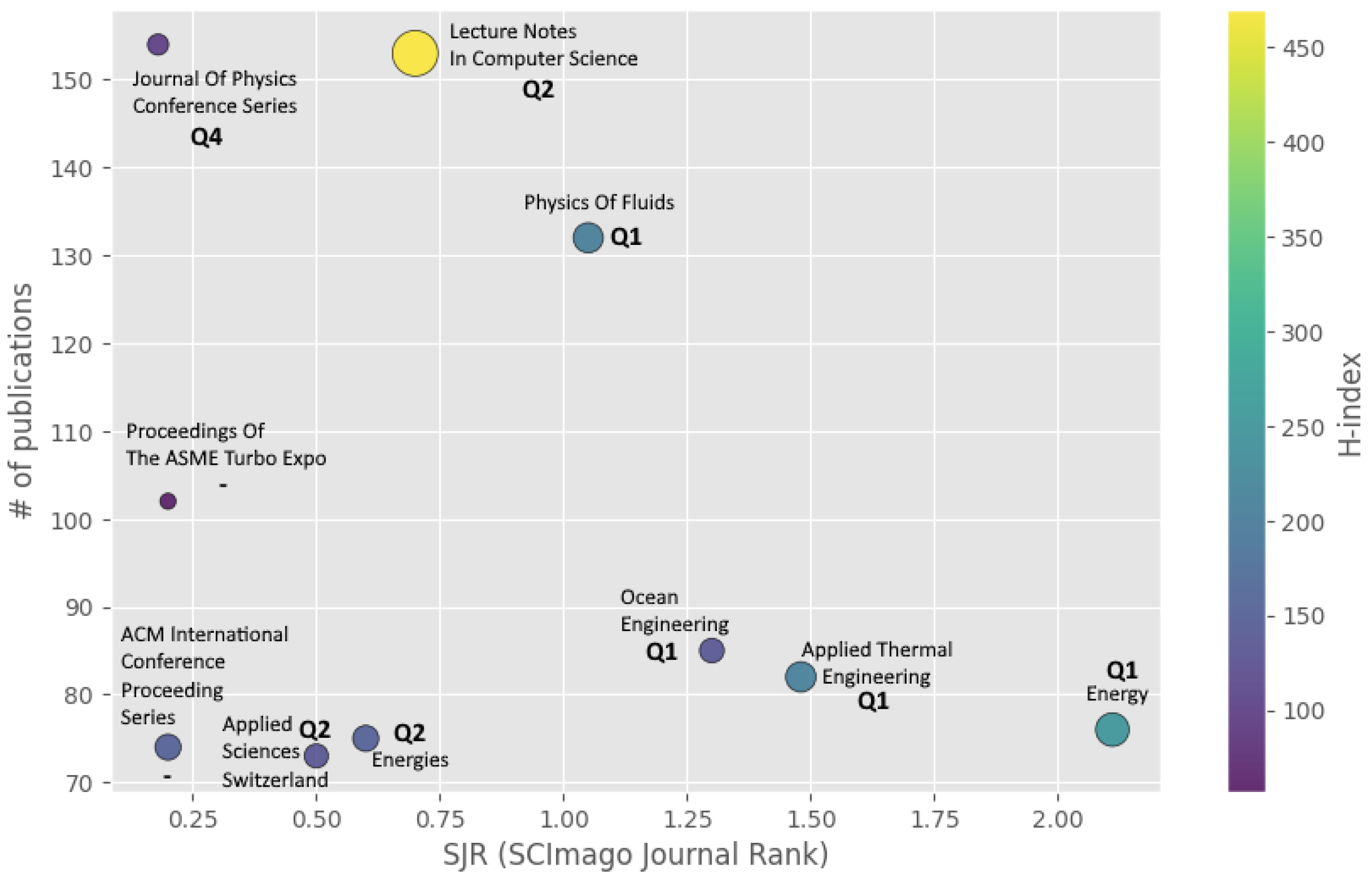
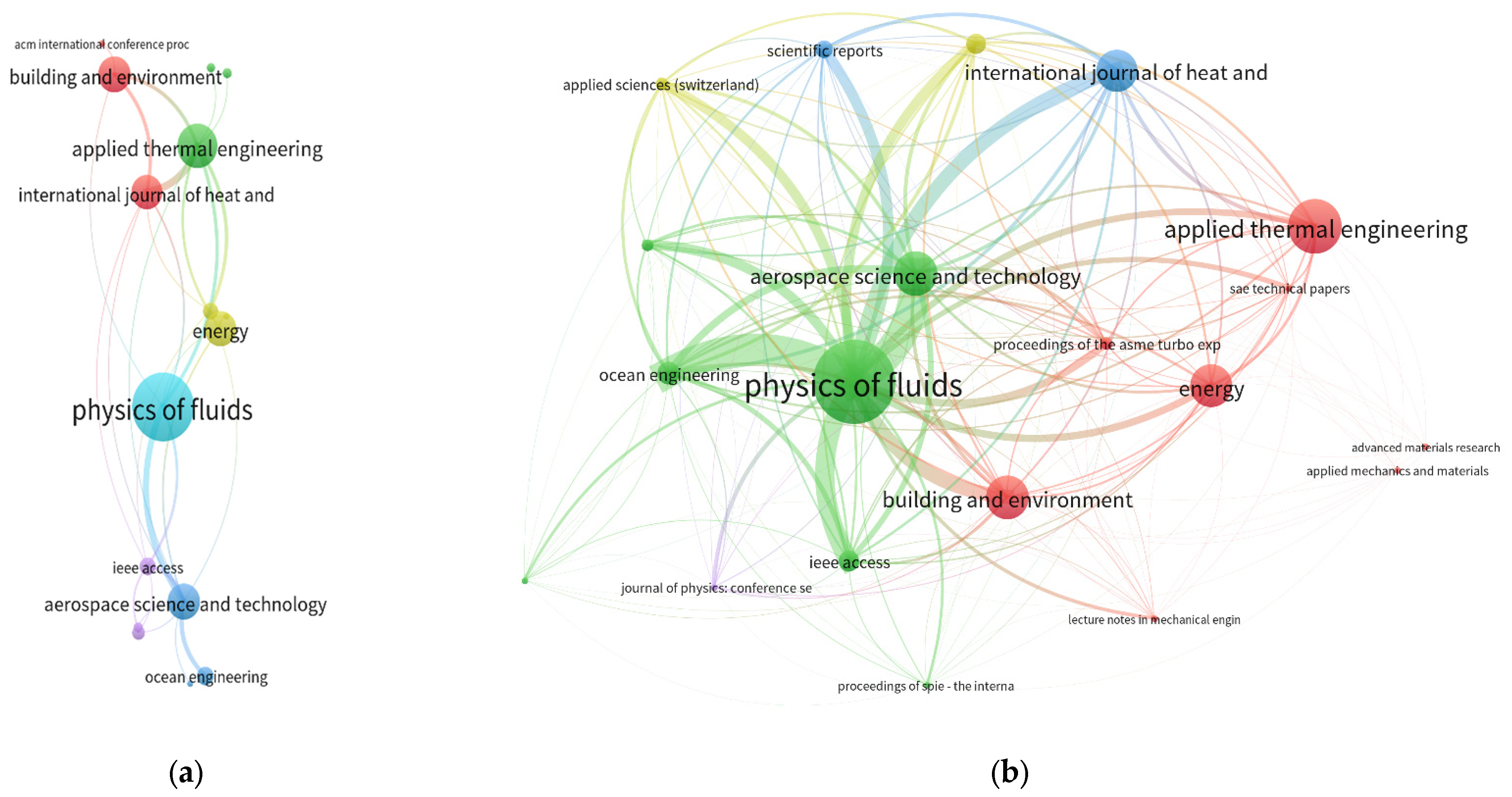

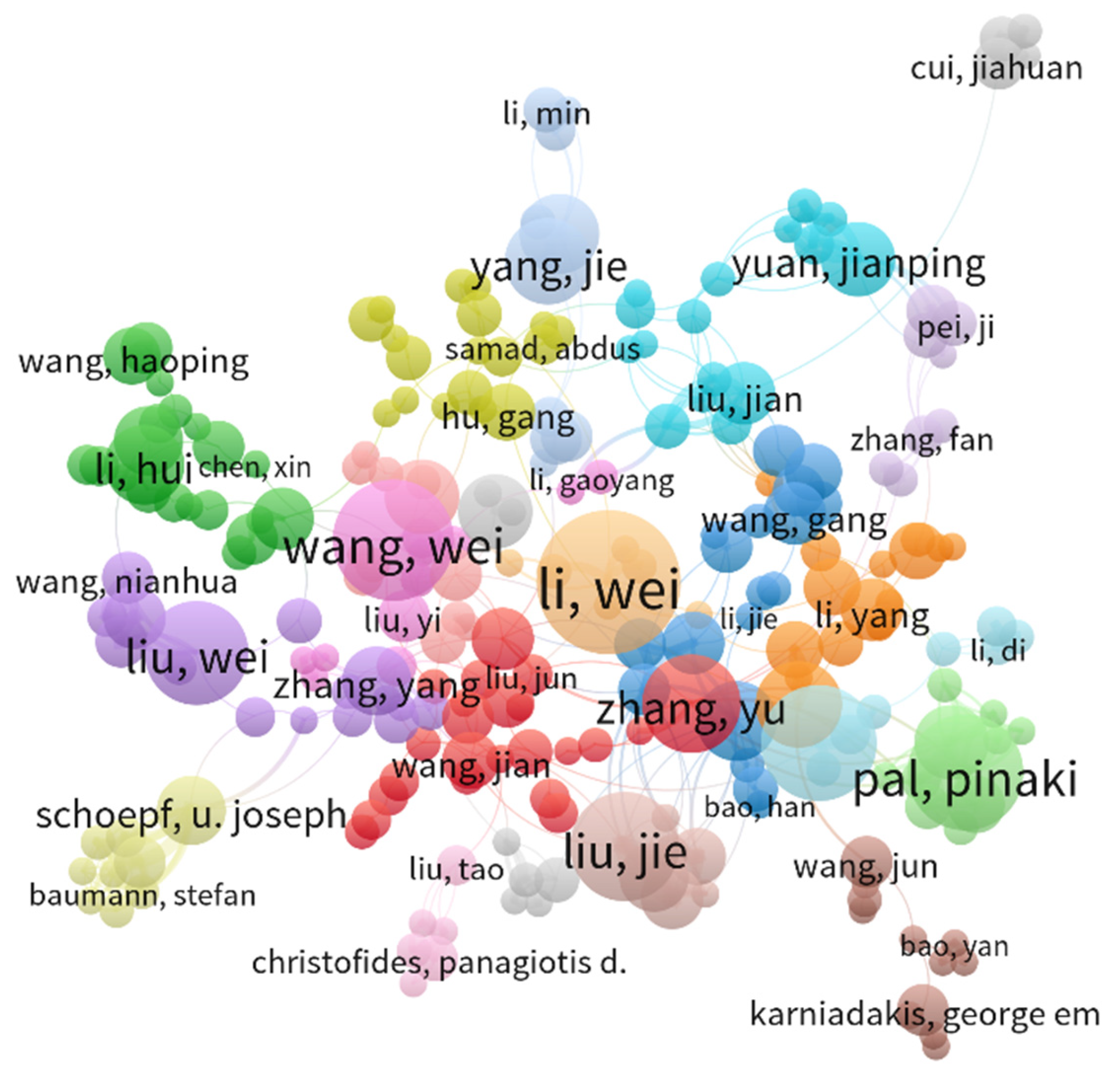
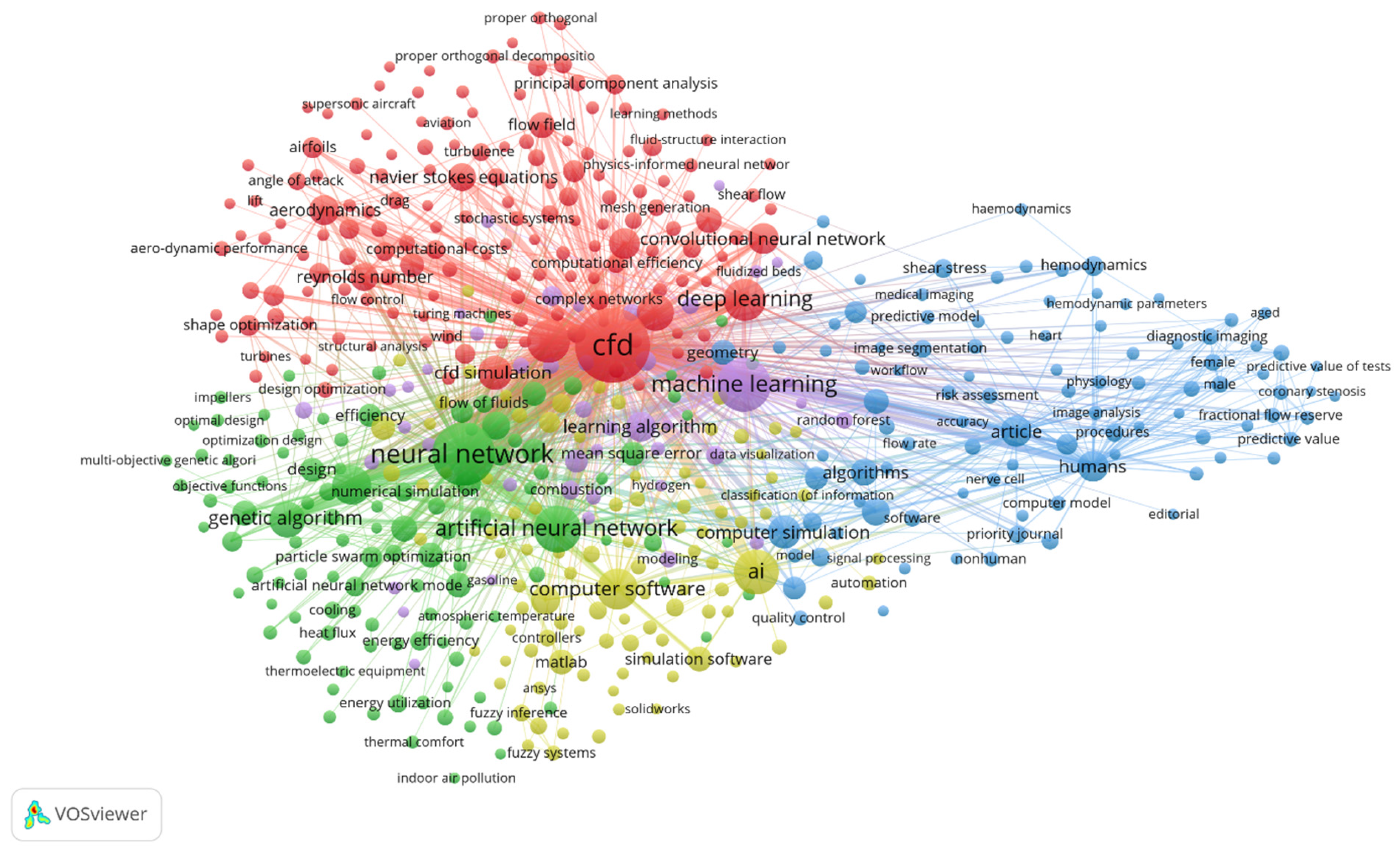
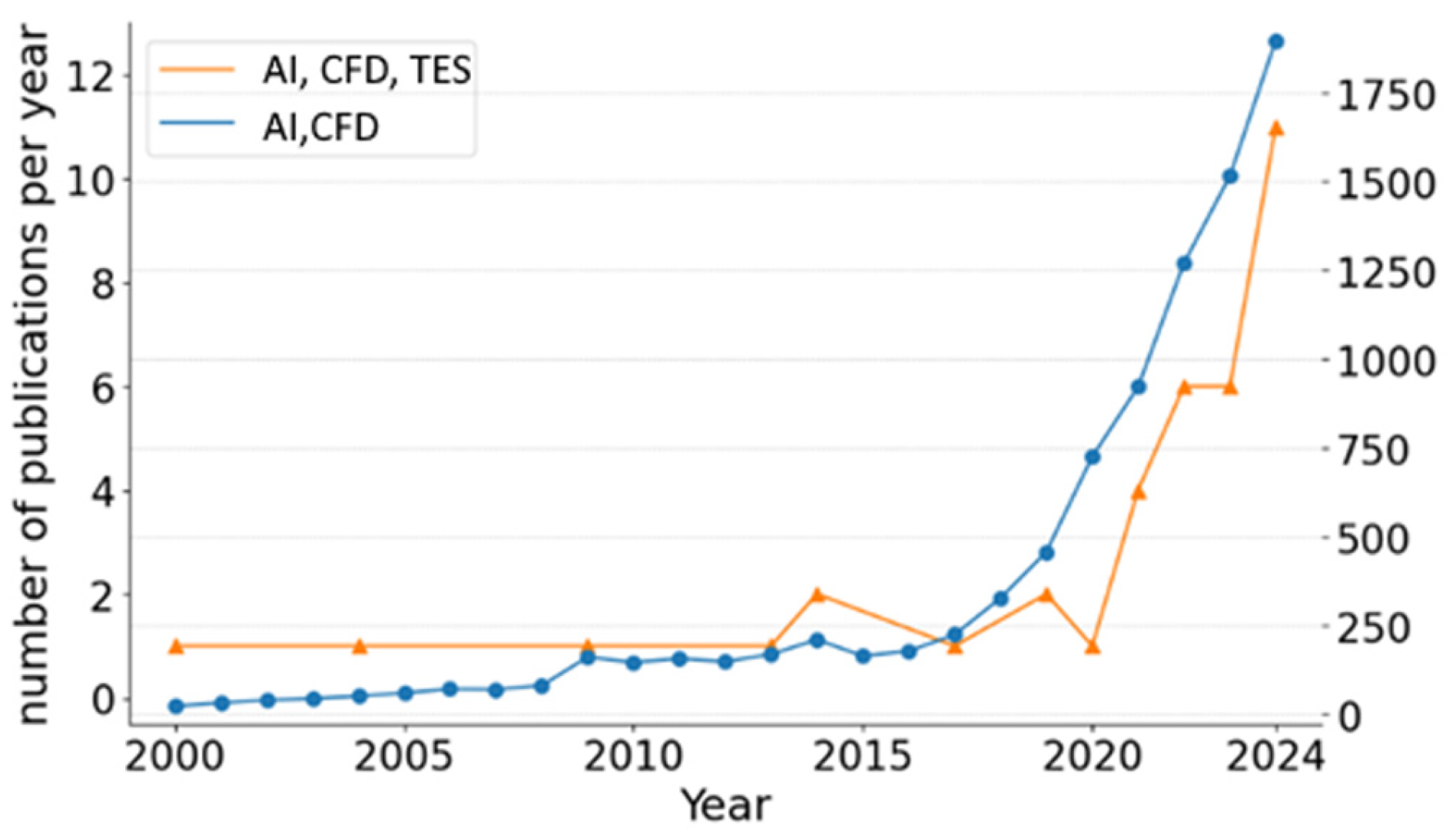


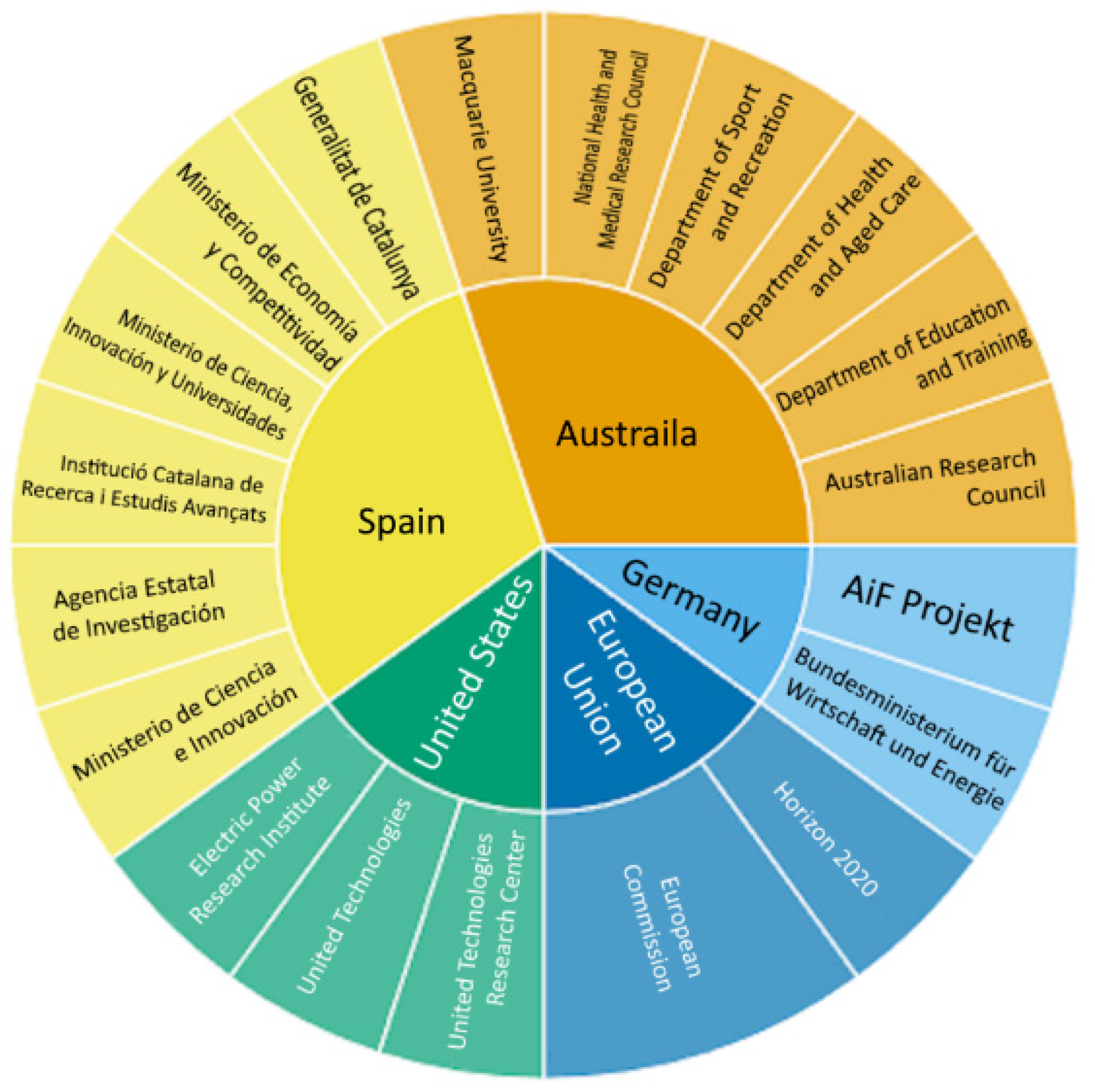
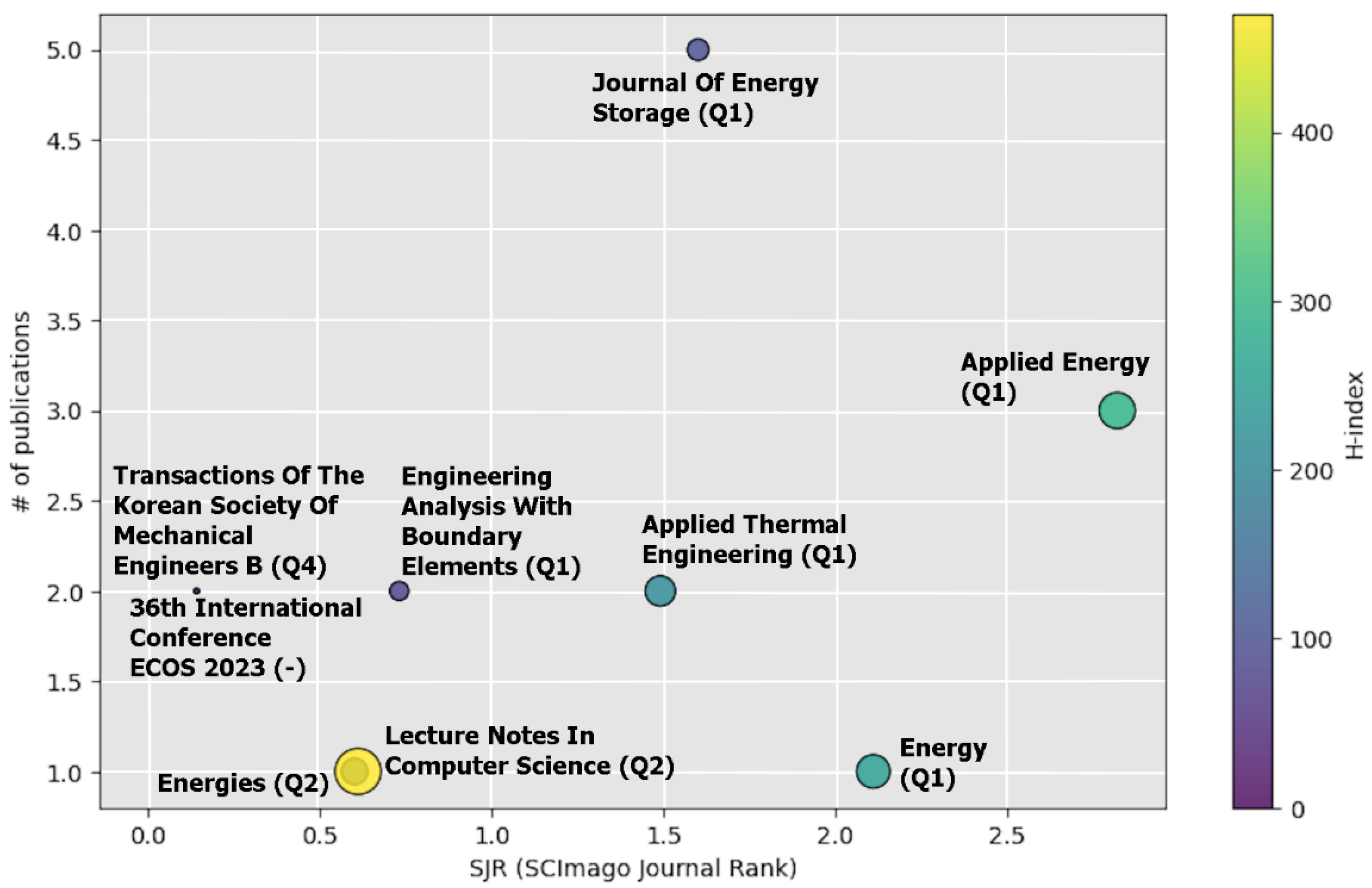

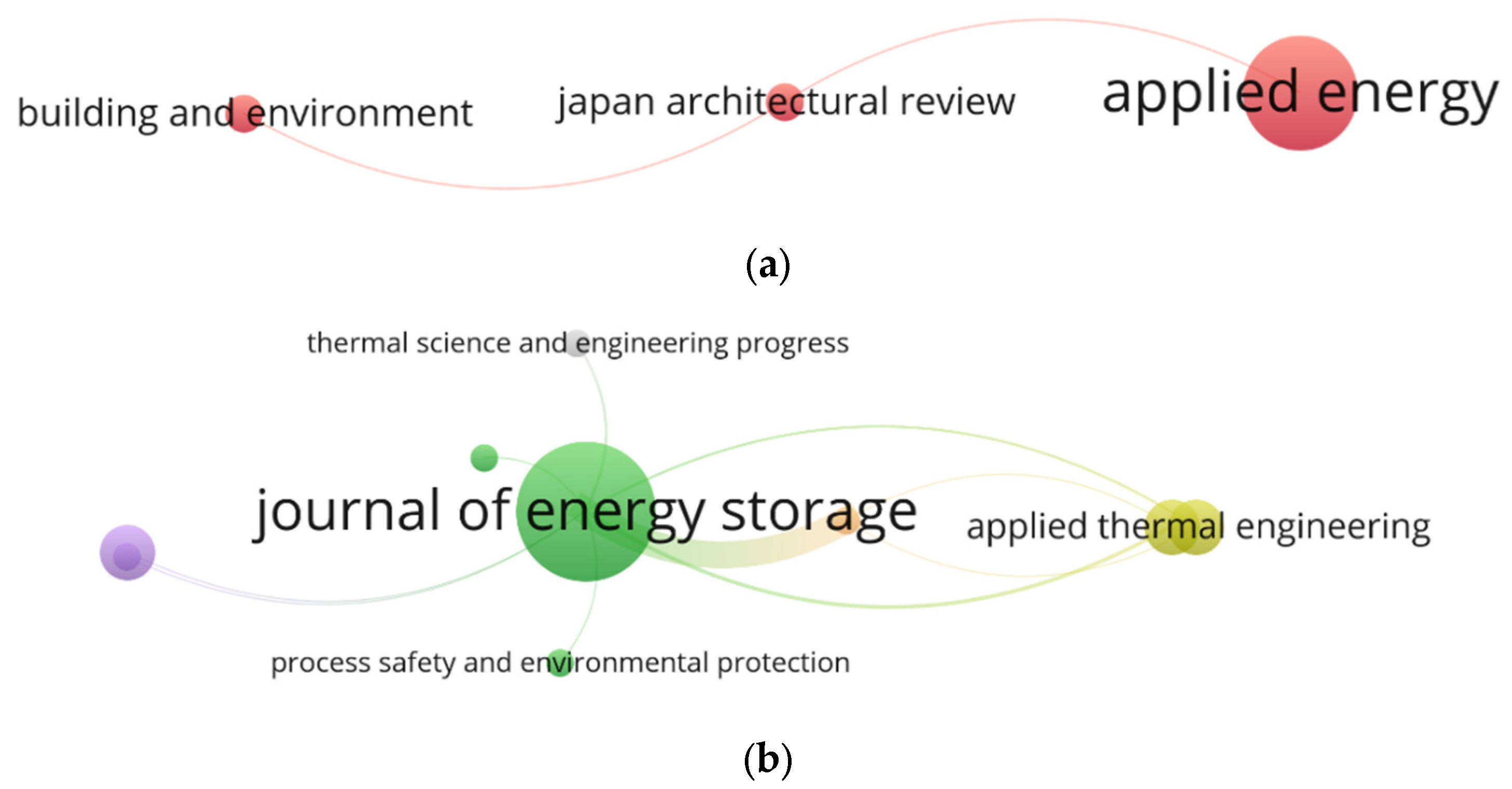
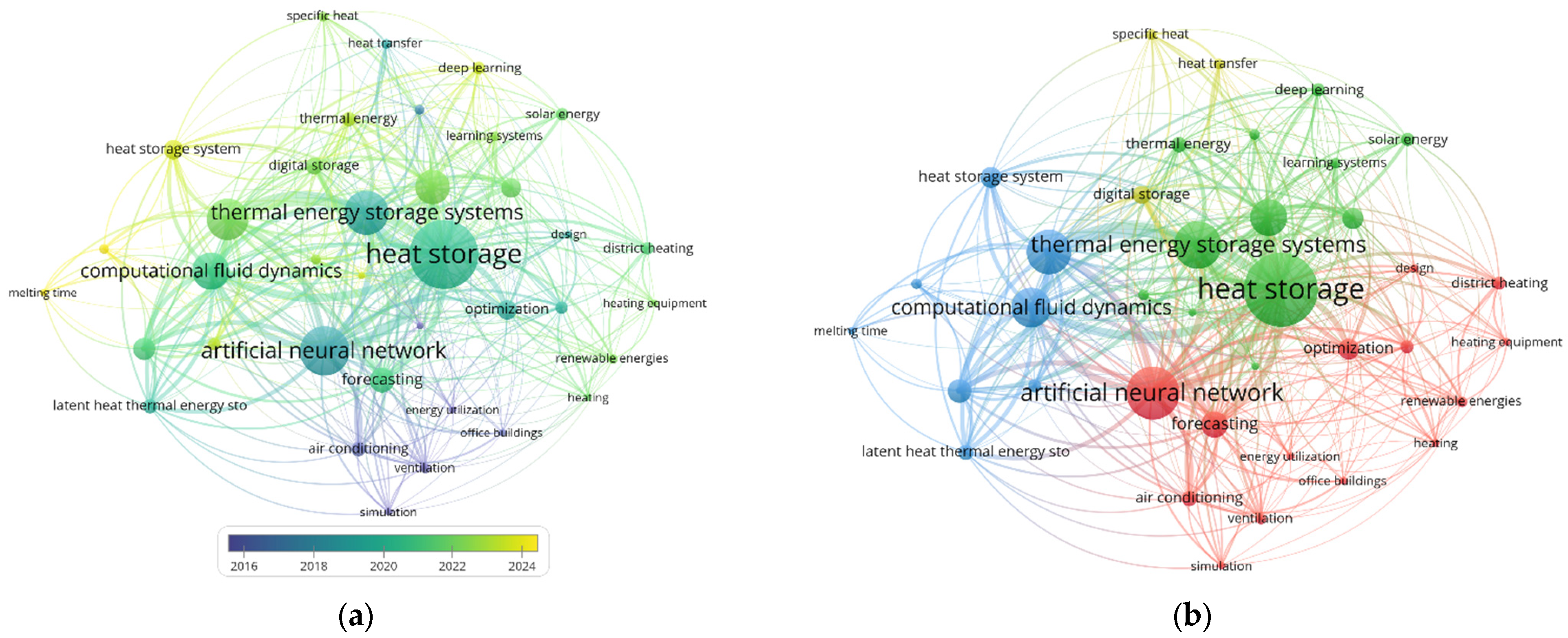
| Topic | Query |
|---|---|
| IA on CFD | (“computational fluid dynamic*” OR “fluid dynamic* simulation” OR “CFD software” OR “comsol” OR “ansys” OR “openfoam” OR “solidWorks” OR “simulation software” OR “CFD”) |
| IA on CFD implemented on TES | (“thermal energy storage” OR “TES tank*” OR “heat storage*” OR “phase change material* storage” OR “latent heat storage*” OR “sensible heat storage*” OR “thermal energy reservoir*” OR “sorption heat storage “) AND (“computational fluid dynamic*” OR “fluid dynamic* simulation” OR “CFD software” OR “comsol” OR “ansys” OR “openfoam” OR “solidWorks” OR “simulation software” OR “CFD”) AND (“artificial* intelligence*” OR “neur* net*” OR “machine learning” OR “deep learning” OR “deep reinforcement learning” OR “artificial intelligence algorithm*” OR “artificial intelligence model*” OR “artificial intelligence technique*”) |
| Affiliation Institutions | # of Publications | Country |
|---|---|---|
| Ministry of Education of the People’s Republic of China | 206 | China |
| Chinese Academy of Sciences | 119 | China |
| Xi’an Jiao tong University | 110 | China |
| Zhejiang University | 108 | China |
| Northwestern Polytechnical University | 105 | China |
| Shanghai Jiao Tong University | 97 | China |
| Tsinghua University | 95 | China |
| Beihang University | 82 | China |
| Harbin Institute of Technology | 82 | China |
| Tianjin University | 79 | China |
| Author | # of Publications | Institution | Country |
|---|---|---|---|
| Babanezhad, Meisam | 33 | Duy Tan University | Vietnam |
| Shirazian, Saeed | 28 | Ton Duc Thang University | Iran |
| Li, Wei | 25 | Southwest Jiao Tong University | China |
| Wang, Wei | 21 | - | China |
| Hang, Weiwei | 20 | Northwestern Polytechnical University | China |
| Marjani, Azam | 20 | Ton Duc Thang University | Vietnam |
| Pal, Pinaki | 20 | Argonne National Laboratory | United States |
| Liu, Jie | 19 | National University of Defence Technology | China |
| Rezakazemi, Mashallah | 18 | Shah rud University of Technology | Iran |
| Liu, Wei | 18 | - | China |
| Affiliation Institutions | # of Publications | Country |
|---|---|---|
| Concordia University | 4 | Canada |
| King Abdulaziz University | 2 | Saudi Arabia |
| China Medical University | 2 | China |
| CNRS (Centre National de la Recherche scientifique) | 2 | France |
| Pusan National University | 2 | South Korea |
| Iran University of Science and Technology | 2 | Iran |
| China Medical University Hospital | 2 | China |
| Universitat de Lleida | 2 | Spain |
| Istanbul Ticaret Üniversitesi | 2 | Turkey |
| Author | # of Publications | Institution | Country |
|---|---|---|---|
| Haghighat, F. | 3 | Concordia University | Canada |
| Akbari, H. | 2 | Concordia University | Canada |
| El-Sawi, A. | 2 | Concordia University | Canada |
| Ha, M.Y. | 2 | Pusan Nat’l Univ. | South Korea |
| Mateu, C. | 2 | Universitat de Lleida | Spain |
| Keyword | Occurrences | Keyword | Occurrences |
|---|---|---|---|
| heat storage | 28 | machine learning | 13 |
| artificial neural network | 20 | forecasting | 10 |
| phase change material | 16 | fins (heat exchange) | 9 |
| thermal energy storage | 16 | optimization | 8 |
| computational fluid dynamics | 15 | learning algorithms | 8 |
Disclaimer/Publisher’s Note: The statements, opinions and data contained in all publications are solely those of the individual author(s) and contributor(s) and not of MDPI and/or the editor(s). MDPI and/or the editor(s) disclaim responsibility for any injury to people or property resulting from any ideas, methods, instructions or products referred to in the content. |
© 2025 by the authors. Licensee MDPI, Basel, Switzerland. This article is an open access article distributed under the terms and conditions of the Creative Commons Attribution (CC BY) license (https://creativecommons.org/licenses/by/4.0/).
Share and Cite
Rojas Cala, E.F.; Béjar, R.; Mateu, C.; Borri, E.; Cabeza, L.F. Artificial Intelligence Applied to Computational Fluid Dynamics and Its Application in Thermal Energy Storage: A Bibliometric Analysis. Appl. Sci. 2025, 15, 7199. https://doi.org/10.3390/app15137199
Rojas Cala EF, Béjar R, Mateu C, Borri E, Cabeza LF. Artificial Intelligence Applied to Computational Fluid Dynamics and Its Application in Thermal Energy Storage: A Bibliometric Analysis. Applied Sciences. 2025; 15(13):7199. https://doi.org/10.3390/app15137199
Chicago/Turabian StyleRojas Cala, Edgar F., Ramón Béjar, Carles Mateu, Emiliano Borri, and Luisa F. Cabeza. 2025. "Artificial Intelligence Applied to Computational Fluid Dynamics and Its Application in Thermal Energy Storage: A Bibliometric Analysis" Applied Sciences 15, no. 13: 7199. https://doi.org/10.3390/app15137199
APA StyleRojas Cala, E. F., Béjar, R., Mateu, C., Borri, E., & Cabeza, L. F. (2025). Artificial Intelligence Applied to Computational Fluid Dynamics and Its Application in Thermal Energy Storage: A Bibliometric Analysis. Applied Sciences, 15(13), 7199. https://doi.org/10.3390/app15137199










